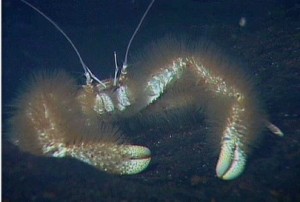Ever heard of the Yeti? The ape-like “monster”, similar to Bigfoot, that inhabits the Himalayan region of Nepal? Well, the Yeti is known to have heavy layers of white fur all over its body. Now, instead of that white fur being on a huge Bigfoot-like creature, imagine it placed on a crab. That is what is known as a “Yeti Crab”, or scientifically called Kiwa Hirsuta.
The Yeti Crab is a crustacean that was first discovered in 2005 by Michel Segonzac, a marine life scientist, that saw this unusually “hairy” creature on a hydrothermal site. So it’s a relatively new species that still is being researched about by scientists. This crab is unlike any other though. It has an average size of about 6 inches long and is specifically unique for its quantity of silky blond setae covering its legs and claws. Setae would refer to the fur-like hair covering it.
If you were to dive under the ocean and see this magnificent creature, you might be tempted to pet it and stroke its fur but keep in mind that it still is a crab. Crabs have pinchers. But as long as you don’t get too close to it, you should be fine since it has very strongly reduced eyes that lack pigment, making it pretty much blind. Don’t worry about them too much though. According to Listverse, Yeti Crabs are often found in depths of more than 2000 meters, and are common on and around hydrothermal vents of the Pacific-Antarctic Ridge. Its diet mainly consists of the tissue of mussels. But unlike humans, these hairy crabs love bacteria and they enjoy devouring them too. The setae that covers the majority of its body often contains heavy sheets of chemosynthetic bacteria that the Yeti Crab can eat whenever hungry. So it pretty much has an unlimited supply of food constantly within a pincher’s length away. The bacteria residing on its fur isn’t just for munching on though. They also assist the creature in detoxifying poisonous minerals from the water that are often emitted by the hydrothermal vents around it. I guess you could say the Yeti Crab doesn’t treat others the way it would like to be treated. It essentially eats the stuff that help it survive.
Another interesting thing to note would be that this Yeti Crab species doesn’t fall perfectly into any of the taxonomic groups that people would often assume are similar to it – such as crabs, lobsters, and shrimp. Scientists have actually proposed for it to be part of a new family called Kiwaidae, which they named after Kiwa. Who’s Kiwa? Well, she is the one and only Polynesian goddess of shellfish.
Since this tiny, hairy monster is such a newly made discovery, there really isn’t much information about it except for the generalities. We don’t know about its breeding patterns, or its other living habits. However, we do know that there are thousands, millions, or even billions of other unknown species waiting to be discovered deep within the ocean. We’ve only explored about 5% of the ocean floor so far. There are countless more exciting creatures out there. We just have to find them in their hidings.
Some of the information was obtained from these sources:



They are so cute! I want one, but I agree if I ever saw one of those things I’d probably bug out. Your blog is very well written and held my attention till the end. I like how your writing style speaks to the audience rather than just echo the facts.
This crab looks awesome. I would probably be really freaked out if I actually saw one in person though. I like the idea of your blog. It is the first time I have read it and I’m excited to continue reading further posts.
That is a freaky looking crab. I like it. It’s unfortunate that they are acclimated to super low ocean depths because I could definitely see them taking off as aquarium pets. Another good animal post as always, keep it up.
What a fascinating creature! This is a really thorough description and examination of an organism that we apparently don’t know much about. It definitely looks soft and welcoming enough to approach, but the fact that it is potentially dangerous at the same time is a valid point. I would love to see this up close someday! This is a well-written and interesting blog post, so nice work!
When I was younger, I used to be obsessed with animal books, so I really like learning about a cool new animal every week. I was fascinated by your description of the Yeti Crab. It’s cool how these animals have adapted to the point of becoming so unique. The setae developed in order for the crab to survive toxic environments, and now it looks like no other creature in the sea. Very interesting!